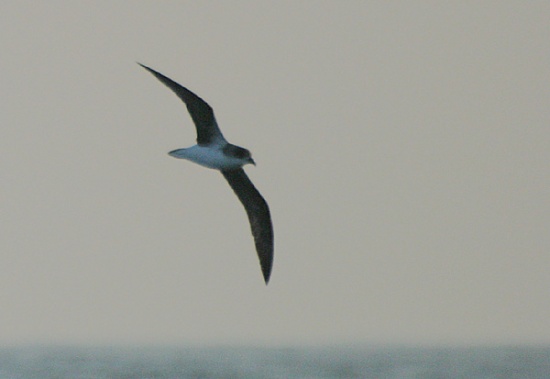m |
|||
| Line 1: | Line 1: | ||
| − | ''' | + | [[Image:Feas_or_Cape_Verde_Islands_Petrel.jpg|thumb|550px|right|Photo by Glen Tepke<br>Photographed: west of [[Isles of Scilly]], UK, 6 September 2004]] |
| + | '''Alternative name: Fea's Petrel''' | ||
;[[:Category:Pterodroma|Pterodroma]] feae | ;[[:Category:Pterodroma|Pterodroma]] feae | ||
| − | + | ||
==Identification== | ==Identification== | ||
| − | + | 33–36 cm. Grey back and wings, dark "W" marking across the wings, dark undersides of wings, white belly. | |
==Distribution== | ==Distribution== | ||
It breeds in the north Atlantic in the [[Cape Verde Islands]] and [[Madeira Islands]] (Bugio Island). | It breeds in the north Atlantic in the [[Cape Verde Islands]] and [[Madeira Islands]] (Bugio Island). | ||
| − | |||
| − | |||
==Taxonomy== | ==Taxonomy== | ||
| − | + | ''P. feae'' was previously considered to be a subspecies of the [[Soft-plumaged Petrel]], ''P. mollis'', but they are actually not closely related at all. However, ''P. feae'' is very closely related to [[Madeira Petrel|Zino's (Madeira) Petrel]], another species recently split from ''P. mollis''. They are estimated to have diverged at the end of the Early Pleistocene, 850.000 years ago (Sangster et al., 2002). Given the uncertainties of molecular dating in Procellariiformes (Rheindt & Austin, 2005), this must be considered very tentative however. | |
| − | P. feae was previously considered to be a subspecies of the Soft-plumaged Petrel, P. mollis, but they are actually not closely related at all. However, P. feae is very closely related to [[Madeira Petrel|Zino's (Madeira) Petrel]], another species recently split from P. mollis. They are estimated to have diverged at the end of the Early Pleistocene, 850.000 years ago (Sangster et al., 2002). Given the uncertainties of molecular dating in Procellariiformes (Rheindt & Austin, 2005), this must be considered very tentative however | ||
| − | |||
| − | |||
==Habitat== | ==Habitat== | ||
| + | Open sea. | ||
==Behaviour== | ==Behaviour== | ||
| + | Nocturnal. | ||
| − | + | It nests in colonies in unused rabbit burrows or ones that it excavates itself. It also nests in holes in rocks; 1 white egg is laid. | |
| − | + | The diet includes planktonic food items from the ocean surface. | |
| − | + | ==References== | |
| + | Wikipedia; Madeira Birds | ||
==External Links== | ==External Links== | ||
{{GSearch|Pterodroma+feae}} | {{GSearch|Pterodroma+feae}} | ||
[[Category:Birds]][[Category:Pterodroma]] | [[Category:Birds]][[Category:Pterodroma]] | ||
Revision as of 22:07, 15 January 2009
Alternative name: Fea's Petrel
- Pterodroma feae
Identification
33–36 cm. Grey back and wings, dark "W" marking across the wings, dark undersides of wings, white belly.
Distribution
It breeds in the north Atlantic in the Cape Verde Islands and Madeira Islands (Bugio Island).
Taxonomy
P. feae was previously considered to be a subspecies of the Soft-plumaged Petrel, P. mollis, but they are actually not closely related at all. However, P. feae is very closely related to Zino's (Madeira) Petrel, another species recently split from P. mollis. They are estimated to have diverged at the end of the Early Pleistocene, 850.000 years ago (Sangster et al., 2002). Given the uncertainties of molecular dating in Procellariiformes (Rheindt & Austin, 2005), this must be considered very tentative however.
Habitat
Open sea.
Behaviour
Nocturnal.
It nests in colonies in unused rabbit burrows or ones that it excavates itself. It also nests in holes in rocks; 1 white egg is laid.
The diet includes planktonic food items from the ocean surface.
References
Wikipedia; Madeira Birds




